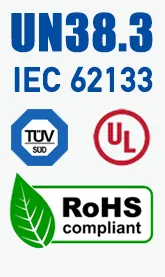
Current Situation & Future Trend of LiPo Battery Cathode Materials
LiPo battery cathode materials have been extensively studied in recent years due to their essential role in lipo batteries. As the demand for lipo batteries continues to grow, so does the need for high-performance cathode materials. This article reviews the current situation and future trends of lipo battery cathode materials. LiPo batteries are the most widely used battery in portable electronic devices, electric vehicles, and grid energy storage applications. The performance of lipo batteries is determined by several factors, including the cathode material used. The most commonly used cathode materials are lithium cobalt oxide (LCO), lithium manganese oxide (LMO), and lithium nickel oxide (LNO). LCO has the highest energy density but is also the most expensive cathode material. LMO has a lower energy density but is cheaper and more stable than LCO. LNO has the lowest energy density but is the most stable of the three cathode materials. The choice of the cathode material is a critical factor in determining the performance and cost of lipo batteries. LCO was the preferred cathode material in the past due to its high energy density.
LiPo batteries are one of the most popular rechargeable batteries on the market today, thanks to their high energy density and low self-discharge rate. But as demand for these batteries continues to grow, so does the need for new and improved cathode materials. In this article, we'll look at the current situation and future trends of lipo battery cathode materials. The most common type of lipo battery cathode is made of lithium cobalt oxide (LiCoO2). This material has a high energy density and is relatively stable, but it is also expensive and has a limited supply. As a result, researchers have been searching for alternative cathode materials that are cheaper and more readily available. One promising alternative is lithium iron phosphate (LiFePO4). This material has a lower energy density than LiCoO2, but it is cheaper and more abundant. LiFePO4 is also more stable, making it a safer choice for batteries. Another alternative cathode material is lithium manganese oxide (LiMn2O4). This material has a slightly higher energy density than LiFePO4, but it is cheaper and more stable.
LiPo batteries are the most popular type of battery for portable electronics, electric vehicles, and energy storage applications due to their high energy density, low self-discharge rate, and good cycling performance. The key to these benefits lies in the cathode materials used in the batteries. This article will review the current situation and future lipo battery cathode materials trends. LiPo battery cathode materials can be broadly classified into three categories: intercalation compounds, conversion compounds, and hybrid compounds. The most common intercalation compounds are lithium cobalt oxide (LiCoO2), lithium manganese oxide (LiMn2O4), and lithium iron phosphate (LiFePO4). Conversion compounds include lithium titanate (Li2TiO3) and lithium vanadium oxide (LiV3O8). Hybrid compounds combine intercalation and conversion compounds, such as lithium manganese cobalt oxide (LiMn1.5Co0.5O4). The choice of cathode material depends on the required battery performance. For example, LiCoO2 is often used in high-power applications such as electric vehicles because it has a high specific capacity.
